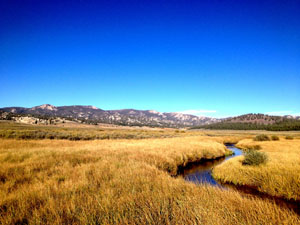Restoration Partnership
Montane stream and meadow restoration partnership


Montane stream-meadow complexes across the Sierra Nevada and Great Basin are critical habitats for a diverse array of aquatic and riparian species including native fishes, amphibians and birds. The vast majority of these systems have, however, experienced more than a century of degradation, resulting in a marked loss of their critical functions including water filtration, flood attenuation, support of biodiversity, and water storage.
Over the past two decades, stream and meadow ecosystem restoration has blossomed into a core component of aquatic ecosystem conservation and recovery. All restoration projects are not, however, created equal. Too often, inadequate understanding of impacted systems has led to unclear or unfocussed restoration goals and ineffective restoration design. These, in combination with a historic lack of science-based approaches to quantifying restoration effects have resulted in many expensive restoration projects that fall short of meeting species and habitat needs.
Prioritizing restoration actions, focusing adaptive management, and making the most of restoration dollars necessitates a scientific approach to evaluating, quantifying, and comparing restoration actions and their results. In response to this opportunity, AEAL has been working in partnership with Trout Unlimited (TU), California Trout (CalTrout), and the University of California, Davis (UCD) to a) evaluate stream and meadow restoration projects in terms of their specific benefit for fish and aquatic habitats and b) quantify the effects of restoration projects over time. Through this work, UNR AEAL Scientists are doing our part to support organizations and practitioners engaged in restoration with science that empowers them to learn from past projects, build a common base of understanding, and measure their successes.
Specific Project Examples:
Stream and Meadow Restoration on the Kern Plateau
In 2013, With support from National Fish and Wildlife Foundation, AEAL and TU’s collaborative “Stream Team” performed an in depth stream and meadow habitat assessment in CA.’s Golden Trout Wilderness. The assessment was part of an ongoing project involving UNR, TU, CalTrout, American Rivers, and the USFS to assess, restore, and conserve stream and meadow habitats on the Kern Plateau. The project team intends to use the study results to help prioritize and design restoration actions tentatively planned for the summer of 2014, as well as to inform forest management in the region, including Grazing practices and other land use with the potential to impact California Golden Trout and their habitat.
The Upper Truckee River: Habitat Assessment for Restoration
In the Upper Truckee River drainage, Lake Tahoe’s largest tributary, stream and meadow restoration projects, both large and small scale are preparing to break ground or already underway. To help ensure that these projects maximize their potential benefits for wild trout and their habitat, AEAL partnered with TU, CalTrout, and UCD to assess restoration efforts on the Upper Truckee. Working collaboratively with restoration practitioners, and using the novel Meadow Restoration Fish Analysis Tool (MRFAT), developed by our coalition, the team identified significant gaps in the information base on physical habitat and its use by fish, risking a range of unintended consequences from the proposed restoration actions, including encouraging proliferation of exotic fish species, and impacts to wild trout and their food supply. To address these risks the team designed and implemented a pilot habitat assessment and monitoring plan for the Upper Truckee restoration reaches that established a baseline for physical habitat conditions, against which practitioners can quantify the direct effects of restoration in terms of both habitat quality, and the response in fish populations over time. This information can then, in turn, guide future adaptive management at restoration sites and the designs for new restoration and enhancement projects within the region and beyond. Our research and monitoring plan for the Upper Truckee River, which received funding support from the National Fish and Wildlife Foundation, is one small example of how the application of science, in combination with collaboration among regional partners, can yield more thoughtful and resource efficient restoration approaches with long-term benefits for fish and their habitats.
